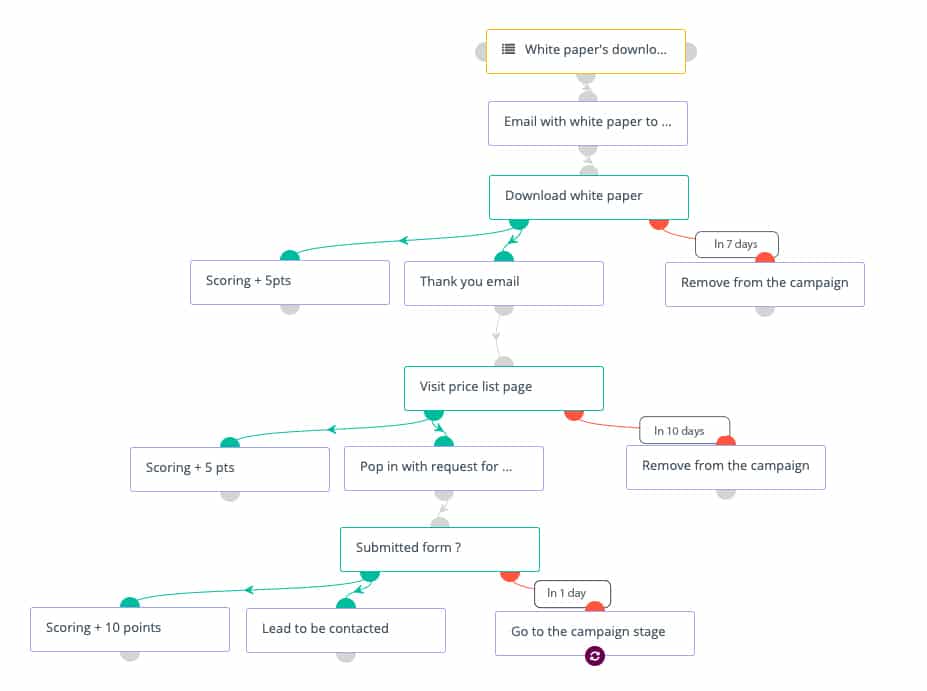On the occasion of the online event, Haute-Savoie Digital Day, Sophie Panot has interviewed three of our clients on the implementation of their marketing automation strategy and its effect on customer acquisition and retention.
A quick reminder about marketing automation:
Marketing automation has two main functions:
– To bring data with the behaviour analysis of your visitors (the famous behavioural tracking). Coupled with the information you already have in your CRM (declarative data), marketing automation allows you to segment your data.
– Automate the relationship with your contacts by setting your different communication channels (email, SMS, lead magnet).
Marketing automation is also 4 phases, for 1 strategy: win and keep your customers! For each stage of the conversion tunnel, implement marketing actions that will convert your prospects into committed customers.
- Attract: acquisition strategy
- Convert: qualification strategy
- Engage: nurturing strategy
- Retain: retention strategy, but also up and add selling
At Webmecanik, we encourage you to follow these 4 steps to a successful marketing automation strategy:
- Define your target prospects to segment your data
- Find your final goal
- Determine the stages of your customer journey between your goal and your segments
- Create the appropriate engaging content
Be careful, never forget your traditional marketing goals, even if you use automated tools.
It is essential to measure the ROI of your actions with KPIs adapted to your strategy. “What cannot be measured, does not exist” Niels Bohr. Webmecanik Automation allows you to monitor your results with a customizable dashboard.
Marketing automation for IT SMEs services
Marketing automation adapts to your problems and to your objectives. The implementation of such a tool must come from the global level and be assimilated by the marketing and sales departments.
At Alticap, Jérôme Loustaneau, business developer, and Yéléna Chaboyan, marketing assistant, worked together with the objective of having qualified and nurtured leads to start the most serene and well-built commercial relationship possible.
This strategy was translated into marketing actions of personalization and especially nurturing of prospects with the creation of rich content and marketing automation scenarios.
Workflow example: Nurturing in B2B
One of the scenarios implemented at Alticap with Webmecanik was on downloading a white paper. A good way to attract your prospects to a specific subject.

This recently implemented scenario has enriched the database created from the social media strategy and increased the visibility of the content on their website.
Marketing automation for innovative startups
On the B2C side, Dorian Rainaud, Digital Marketing Manager at In&motion wanted to implement a marketing automation strategy to support sales growth but also to create a link with direct customers. Two strategies were therefore implemented.
Workflow example: Nurturing in B2C
The first step was to determine the different personas to address the right message to the right person. It was necessary to adapt the commercial pitch and therefore create personalized communications.

Workflow example: Reactivation of inactive leads
The second scenario implemented at In&motion was the reactivation of inactive leads. The database in question had been built up at the time of an event two years earlier. These contacts had to be reactivated in a gentle way by sending them gradual communications with information about the company’s news.
The results of these campaigns lived up to the company’s expectations!
- 100 leads converted → 90% opened at least one nurturing lead
- opening rate of more than 50%
- much higher conversion rate thanks to marketing automation
- Unsubscribe rate: thanks to personalization below 2%
- Transformation rate of more than 150%
Marketing automation for a mixed private/public company
Elsa Baldan, digital manager at ATMB, has implemented a marketing automation scenario to convert abandoned shopping carts on the company’s e-commerce site.
Each month, more than 250 prospects do not complete the purchase of their subscription. The problem was therefore to set up a scenario to accompany these unknown prospects in a conversion channel. The challenge here was to create a link and work on customer knowledge.
Example scenario: Conversion from abandoned carts
A fairly simple scenario was set up for this first test. When a person does not complete the course, ATMB sends them an initial e-mail to propose offers that are better suited to their needs. Elsa was keen to adopt a non-aggressive approach that corresponds to the company’s values.
“The way I create my relationship online is a duplicate of the relationship I would like to have face to face. Marketing automation is not a tool for overpressure if you stay true to your values and the way you communicate. It allows better communication and more fluidity.” Elsa Baldan
This first approach to marketing automation was a POC (Proof Of Concept) for ATMB. A success that allows the marketing automation tool to be fully taken into account for the future website makeover.
Some tips to begin with marketing automation
Start simple
If you want to implement marketing automation throughout your buying and retention journey, we recommend creating several simple scenarios. Move your prospects and customers from one scenario to another one in order to enable more agile management of your conversion process.
Visible results in the long term
Don’t be discouraged if your results don’t seem optimal after the first month of implementation. Unlike outbound marketing, inbound results are visible and sustainable. “It can take a long time to set up a scenario, to test it or to modify it according to the results obtained. These results are sometimes visible in the longer term, depending on your buying cycle,” says Yéléna Chaboyan.
Include your IT department in the project
Don’t forget that in the implementation of a software project, the IT department is important. Many parameters come into play and are sometimes key to the proper functioning of a tool. In particular, it is essential to pay close attention to synchronisation with your CRM. Elsa Baldan agrees.
Conclusion
Marketing automation is a tool that allows you to respond to many marketing and sales issues. Through the different examples above you can see that this kind of strategy adapts to your needs whether you are a B2B or B2C company, whether you have an e-commerce or not.
Marketing automation is not a magic tool. It will not replace your marketing team, but it will free them from repetitive tasks so that they can concentrate on strategic actions.
Finally, keep in mind that a few prerequisites are necessary for the implementation of such a project: having a dedicated person in your company (or outsourced) to manage the strategy and the tool, taking into account the decision cycle and setting up indicators to measure your ROI and, above all, choose the right tool for your needs.





